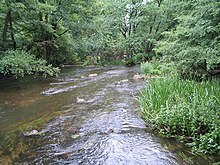Warnow
| Warnow | |
|---|---|
 | |
| Location | |
| Country | Germany |
| State | Mecklenburg-Vorpommern |
| Physical characteristics | |
| Source | |
| • location | Mecklenburg |
| Mouth | |
• location | Baltic Sea |
• coordinates | 54°10′54″N 12°5′32″E / 54.18167°N 12.09222°E |
| Length | 155.4 km (96.6 mi) |
| Basin size | 3,324 km2 (1,283 sq mi) |

The Warnow (German pronunciation: [ˈvaʁno]) is a river in the state of Mecklenburg-Vorpommern in Germany. It flows into the Baltic Sea near the town of Rostock, in its borough Warnemünde.
The source of the Warnow is in Grebbin, a small village 10 kilometres (6 mi) north of
before reaching Rostock.In 2003, Germany's first modern toll road, the Warnow Tunnel was opened, connecting the port of Rostock on the east bank with the west bank of the river.
There is in Indaial, a city of Brazil, a river with the same name. When Hermann Blumenau came to America and started to explore the country, he gave this name to the river in the Brazilian city because it resembled the river in Germany.
Names and etymology
The origins of the name are uncertain. Recent work suggests a non-Indo-European (perhaps specifically
References
- ^ Hanswilhelm Haefs, Ortsnamen und Ortsgeschichten auf Rügen mitsamt Hiddensee und Mönchgut: Anmerkungen zur Geschichte (Books on Demand, 2003), p. 14.
- ^ Claudius Ptolemaios: Geographike Hyphegesis, Ch. 11: Germania Magna.
- ^ Saxo Grammaticus, Gesta Danorum: The History of the Danes, ed. by Karsten Friis-Jensen, trans. by Peter Fisher, 2 vols (Oxford: Clarendon Press, 2015), II 1168 n. 155.
- ^ Nikolaĭ Mikhaĭlov, Mitologia slava: studi sulla mitologia dei popoli slavi. Antologia, Studi Slavi, 1 (Pisa: Universita degli studi di Pisa, Istituto di lingua e letteratura russa, 1995), p. 54.
- ^ Hanswilhelm Haefs, Ortsnamen und Ortsgeschichten auf Rügen mitsamt Hiddensee und Mönchgut: Anmerkungen zur Geschichte (Books on Demand, 2003), p. 14.
